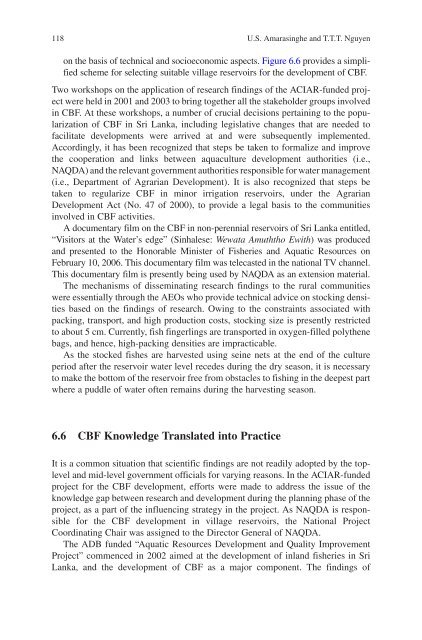Success Stories In Asian Aquaculture - Library - Network of ...
Success Stories In Asian Aquaculture - Library - Network of ...
Success Stories In Asian Aquaculture - Library - Network of ...
- No tags were found...
You also want an ePaper? Increase the reach of your titles
YUMPU automatically turns print PDFs into web optimized ePapers that Google loves.
118 U.S. Amarasinghe and T.T.T. Nguyenon the basis <strong>of</strong> technical and socioeconomic aspects. Figure 6.6 provides a simplifiedscheme for selecting suitable village reservoirs for the development <strong>of</strong> CBF.Two workshops on the application <strong>of</strong> research findings <strong>of</strong> the ACIAR-funded projectwere held in 2001 and 2003 to bring together all the stakeholder groups involvedin CBF. At these workshops, a number <strong>of</strong> crucial decisions pertaining to the popularization<strong>of</strong> CBF in Sri Lanka, including legislative changes that are needed t<strong>of</strong>acilitate developments were arrived at and were subsequently implemented.Accordingly, it has been recognized that steps be taken to formalize and improvethe cooperation and links between aquaculture development authorities (i.e.,NAQDA) and the relevant government authorities responsible for water management(i.e., Department <strong>of</strong> Agrarian Development). It is also recognized that steps betaken to regularize CBF in minor irrigation reservoirs, under the AgrarianDevelopment Act (No. 47 <strong>of</strong> 2000), to provide a legal basis to the communitiesinvolved in CBF activities.A documentary film on the CBF in non-perennial reservoirs <strong>of</strong> Sri Lanka entitled,“Visitors at the Water’s edge” (Sinhalese: Wewata Amuththo Ewith ) was producedand presented to the Honorable Minister <strong>of</strong> Fisheries and Aquatic Resources onFebruary 10, 2006. This documentary film was telecasted in the national TV channel.This documentary film is presently being used by NAQDA as an extension material.The mechanisms <strong>of</strong> disseminating research findings to the rural communitieswere essentially through the AEOs who provide technical advice on stocking densitiesbased on the findings <strong>of</strong> research. Owing to the constraints associated withpacking, transport, and high production costs, stocking size is presently restrictedto about 5 cm. Currently, fish fingerlings are transported in oxygen-filled polythenebags, and hence, high-packing densities are impracticable.As the stocked fishes are harvested using seine nets at the end <strong>of</strong> the cultureperiod after the reservoir water level recedes during the dry season, it is necessaryto make the bottom <strong>of</strong> the reservoir free from obstacles to fishing in the deepest partwhere a puddle <strong>of</strong> water <strong>of</strong>ten remains during the harvesting season.6.6 CBF Knowledge Translated into PracticeIt is a common situation that scientific findings are not readily adopted by the topleveland mid-level government <strong>of</strong>ficials for varying reasons. <strong>In</strong> the ACIAR-fundedproject for the CBF development, efforts were made to address the issue <strong>of</strong> theknowledge gap between research and development during the planning phase <strong>of</strong> theproject, as a part <strong>of</strong> the influencing strategy in the project. As NAQDA is responsiblefor the CBF development in village reservoirs, the National ProjectCoordinating Chair was assigned to the Director General <strong>of</strong> NAQDA.The ADB funded “Aquatic Resources Development and Quality ImprovementProject” commenced in 2002 aimed at the development <strong>of</strong> inland fisheries in SriLanka, and the development <strong>of</strong> CBF as a major component. The findings <strong>of</strong>
















